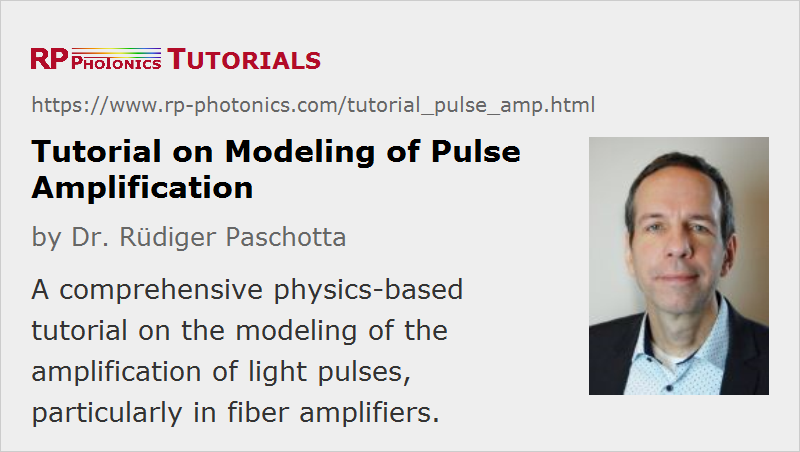Tutorial: Modeling of Pulse Amplification
This is part 4 of a tutorial on pulse amplification modeling from Dr. Paschotta. The tutorial has the following parts:
2: Gain saturation
3: Simulating pumping and pulse amplification
4: Multimode amplifiers
5: Amplified spontaneous emission
6: Bulk amplifiers
Part 4: Multimode Amplifiers
While many fiber amplifiers are based on a single-mode fiber, some (particularly those for high powers) have a few-mode fiber or even a strongly multimode fiber. That leads us to the question whether that is relevant for simulations. The short answer: it depends.
If a multimode fiber amplifier keeps most of the signal power in its fundamental mode (as one often tries to achieve), there is nothing special to do for a simulation – just use the fundamental mode profile for the signal. In the following, however, we assume that we have substantial signal powers in different modes.
Mode-dependent Gain
If we ignore the multimode nature of a fiber, in the simulation model that means that we just use a fixed transverse intensity profile which may cover a larger area than the fundamental guided mode alone. That is okay in many cases; only that way we ignore that the gain and the losses are mode-dependent. The typically lower gain and possibly higher propagation losses for higher-order modes make their powers grow less quickly than those of the fundamental mode. So the effective gain for the combination of all modes will also get reduced.
But how strong is that effect? That depends not only on by what percentage e.g. the gain of higher-order modes is reduced (e.g. by a lower overlap with the doped fiber core), and how the power is distributed over the modes, but also on the magnitude of the gain: the more gain we have, the larger are the gain differences. If the fundamental mode has a high gain of e.g. 40 dB, a higher-order mode with 25% less gain (as can occur in practice) will already have 10 dB less! So the relative power distribution over the modes may change a lot.
We may thus want to make our model more sophisticated by using separate optical channels for the different fiber modes, maybe every time combining modes with same intensity profiles except for different orientations (as occur for LP modes with non-zero <$l$>) into one channel. Each channel has of course its own power evolution, and we get the full picture. In RP Fiber Power, we can use the mode solver to calculate all mode profiles and the resulting core overlap, which influences the modal gain. The diagram gives you an example from a demo file delivered with RP Fiber Power, where effects of mode-dependent gain can be clearly seen:

Only, that approach will no longer be realistic if we have mode mixing, e.g. through bending of the fiber; that can often hardly be modeled as we do not know how exactly the modes are coupled. If well defined mode mixing is generated e.g. by bending the fiber, one may need to employ numerical beam propagation, effectively propagating beam profiles rather than mode powers.
Mode-dependent Group Delays
For picosecond and femtosecond pulses, we have another issue: mode-dependent group delays, a phenomenon also called intermodal dispersion. In the nanosecond regime, we can usually ignore that, as this problem amounts only to some picoseconds per meter, and amplifier fibers are usually not that long. Compared with ultrashort pulse durations, however, such difference in propagation time can be rather large. So we get the output pulses for different modes at substantially different times. Therefore, applications where that may matter are usually done with single-mode fibers.
If needed, we can simulate such things. Our software RP Fiber Power essentially does only single-mode propagation for ultrashort pulses, but we can call that function once for every mode (each one again having a separate optical channel); that only implies that we cannot simulate interactions between those modes, and are limited to cases with weak gain saturation.
Conclusions
A few conclusions from this part of the tutorial:
- In nanosecond amplifiers, we may have substantial effects of mode-dependent gain. That can well be treated in a simulation model.
- For ultrashort pulses, we also need to consider intermodal dispersion.
Go to Part 5: Amplified spontaneous emission or back to the start page.
Questions and Comments from Users
Here you can submit questions and comments. As far as they get accepted by the author, they will appear above this paragraph together with the author’s answer. The author will decide on acceptance based on certain criteria. Essentially, the issue must be of sufficiently broad interest.
Please do not enter personal data here. (See also our privacy declaration.) If you wish to receive personal feedback or consultancy from the author, please contact him, e.g. via e-mail.
By submitting the information, you give your consent to the potential publication of your inputs on our website according to our rules. (If you later retract your consent, we will delete those inputs.) As your inputs are first reviewed by the author, they may be published with some delay.


Share this with your network:
Follow our specific LinkedIn pages for more insights and updates: